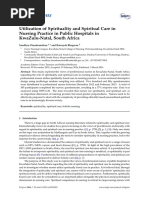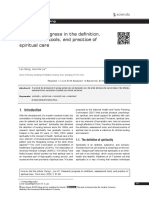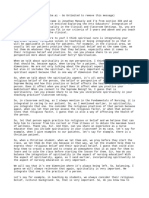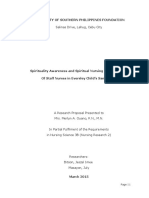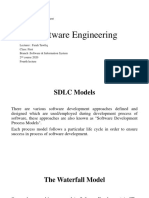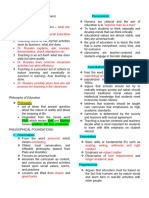Spirituality and Spiritual Care in Nursing Fundamentals Textbooks
Uploaded by
NilaSa'diyahSpirituality and Spiritual Care in Nursing Fundamentals Textbooks
Uploaded by
NilaSa'diyahSpirituality and Spiritual Care in Nursing
Fundamentals Textbooks
Barbara Pesut, PhD, RN
M
Abstract rs. M. was admitted to a medical unit with a new,
Educators are increasingly being called on to teach potentially life-threatening, diagnosis of cancer.
nursing students the fundamentals of spiritual care. The She felt anxious and feared the implications of
purpose of this study was to investigate and analyze what this diagnosis, given how it would affect her life’s goals.
was being taught to nursing students about spirituality She wondered why this would happen to her and where
and spiritual care through nursing fundamentals text- God is in all of this. If she shares these thoughts with her
books. Findings of this study suggest that although this nurse, she will receive a diagnosis of altered spiritual func-
body of literature provides comprehensive content about tion; she exhibits maladaptive expressions of spiritual
spirituality and spiritual care, there are some underly- needs, a dysfunction that requires nursing intervention.
ing conceptual problems. The clear demarcation between On the basis of this diagnosis, her nurses will intervene
spirituality and religion creates problematic dichotomies through spiritual support, evaluating her progress until
between patients’ individual and cultural selves and their she reaches a state of spiritual well-being. How will she
cognitive and experiential selves. Defining spirituality and the nurses know when she has reached this state? She
primarily by positive emotional descriptors and cognitive will feel peaceful, connected, forgiving, loving, balanced,
capacity tends to pathologize the basic human experience integrated, and hopeful. The nurse will wait for her to ex-
of suffering and marginalize those most vulnerable in so- press understanding and acceptance of her situation.
ciety. Spiritual care is problematic in that it is difficult to The scenario described above is a typical description of
identify what constitutes a uniquely spiritual interven- spiritual care in nursing textbooks. The scenario provokes
tion, the outcomes being proposed for care are question- a number of questions, particularly if the reader is the pa-
able, and there is an assumption that nurses’ spiritual tient. A patient may ask, “Would I want this diagnostic
worldviews are biases in the context of care. language used to describe my struggles in the face of ill-
ness? Would I want the nurse to intervene in this aspect
of my life? Are these experiential descriptors of spiritual
Received: April 26, 2006 well-being realistic amid my suffering?”
Accepted: July 30, 2006 Spirituality and spiritual care in nursing are increas-
Dr. Pesut is Assistant Professor of Nursing, University of British ingly characterized by three common assumptions. First,
Columbia, Okanagan, Kelowna, British Columbia, Canada. At the time all individuals have a spiritual nature, whether or not they
this article was written, Dr. Pesut was Associate Professor and Chair of agree with that claim. Second, spiritual care is an ethi-
Nursing, Trinity Western University, Langley, British Columbia, Canada. cal responsibility of holistic nursing care. Although most
This study was funded by the Social Sciences and Humanities ethical codes would phrase this responsibility as being
Research Council/Trinity Western University Aid to Small Universi- respectful and supportive of patients’ spiritual practices,
ties grant. The author thanks Destiny Loeve for her assistance in the nursing literature has gone beyond the notions of re-
gathering the data for this study and Rick Sawatzky for his helpful spect and support to intervention. Third, many nurses are
feedback on a draft of this article. unprepared for spiritual care, which is a neglected area
Address correspondence to Barbara Pesut, PhD, RN, Assistant of practice. The call is often made for more education so
Professor of Nursing, University of British Columbia, Okanagan, nurses can become competent in this form of care.
3333 University Way, Kelowna, BC V1V 1V7, Canada; e-mail: barb. The literature on spiritual care frequently cites three
pesut@ubc.ca. primary nursing competencies related to spirituality: self-
April 2008, Vol. 47, No. 4 167
Spirituality in nursing fundamentals textbooks
lated to spirituality and
Table 1 spiritual care specifically
Nursing Fundamentals Textbooks used for Analysis in this Study in first-year nursing fun-
damentals textbooks. Ten
Berger, K.J., & Williams, M.B. (1999). Fundamentals of nursing: Collaborating for optimal health (2nd
textbooks (Table 1) were
ed.). Stamford, CT: Appleton & Lange.
reviewed and analyzed us-
Craven, R.F., & Hirnle, C.J. (2003). Fundamentals of nursing: Human health and function (4th ed.). ing a philosophic inquiry.
Philadelphia: Lippincott Williams & Wilkins. Eligible textbooks were
Daniels, R. (2004). Nursing fundamentals: Caring and clinical decision making. Clifton Park, NY: identified through the web
Delmar Learning. sites of major publishing
DeLaune, S.C., & Ladner, P.K. (2002). Fundamentals of nursing: Standards & practice (2nd ed.). houses. To be included in
Albany, NY: Delmar Thomson Learning. the study, the title of the
Du Gas, B.W., Esson, L., & Ronaldson, S.E. (1999). Nursing foundations: A Canadian perspective textbook needed to contain
(2nd ed.). Scarborough, ON: Prentice Hall Canada. the language of fundamen-
tals (or foundations), to be
Harkreader, H.C., & Hogan, M.A. (2004). Fundamentals of nursing; Caring and clinical judgement.
aimed toward a student
St. Louis, MO: Saunders.
audience preparing to be-
Kozier, B. (2004). Fundamentals of nursing: The nature of nursing practice in Canada. Toronto, ON: come an RN, and to have
Prentice Hall. at least some content re-
Lindeman, C.A., & McAthie, M. (1999). Fundamentals of contemporary nursing practice. lated to spirituality.
Philadelphia: Saunders. Philosophic inquiry is
Potter, P.A., Perry, A.G., Kerr, J.C., & Wood, M.J. (2006). Canadian fundamentals of nursing (3rd ed.). useful for addressing what
Toronto, ON: Mosby. Edwards (2001) referred to
Taylor, C., Lillis, C., & LeMone, P. (2005). Fundamentals of nursing: The art and science of nursing as second-order questions.
care (5th ed.). Philadelphia: Lippincott Williams & Wilkins. These questions seek to
clarify the underlying
concepts and assumptions
within a particular dis-
awareness, knowledge about religion and spirituality, course that cannot be answered through scientific means.
and how to implement spiritual care in a nursing context Philosophic inquiry can also play a deconstructive role in
(Greenstreet, 1999; Narayanasamy, 1999). van Leeuwen seeking to reveal potential distortions. The method uses
and Cusveller (2004) conducted a literature review with the conceptualizing, judging, and reasoning processes of
the purpose of describing a set of nursing competencies the researcher to ask an ever-deepening cycle of questions
for spiritual care. Their results were described in terms of around a particular problem. In this study, the method
three core domains and six competencies. The three core was used to identify those concepts and assumptions about
domains were “awareness and use of self, spiritual dimen- spirituality and spiritual care that are potentially prob-
sions of the nursing process, and assurance and quality of lematic and need to be considered further when educating
expertise” (p. 234). This final core domain addressed the practitioners on this aspect of nursing care. Problematic
institutional processes and characteristics that contrib- issues were identified using a pragmatic approach. Con-
uted to quality spiritual care. The six spiritual care com- tent related to spirituality and spiritual care were con-
petencies were “handling one’s own beliefs, addressing the tinually tested by the question of what implications this
subject, collecting information, discussing and planning, approach may have for the practicing nurse.
providing and evaluating, and integrating into policy” (p. The research began with a series of questions about
234). the textbook content related to spirituality and spiritual
In light of this call to prepare nurses for competence in nursing care (Table 2). These questions were derived from
spiritual care, the purpose of this study was to investigate the understanding that the nature of philosophic inquiry
and analyze what was being taught to first-year nursing concerns “common” as opposed to “special” experience
students about spirituality and spiritual care through as described by Adler (Simmons, 1992, p. 15). Questions
nursing fundamentals textbooks. McEwen’s (2004) analy- were selected that would typify common questions nurses
sis of spirituality content in nursing textbooks provided a may have related to spiritual care such as, “What is it?”,
helpful overview and summary of the core content found “What is my role as a nurse?”, “What interventions are en-
in various categories of nursing textbooks, including six tailed?”, and “How do I know that I have been effective?”
nursing fundamentals textbooks. She calculated the per- These questions had been tested in an analysis of a dif-
centage of pages devoted to the topic, commented on the ferent body of literature. The answers to these questions
various chapter headings and the content contained in led to other questions such as, “What are the underlying
the chapters, and characterized the content in nursing assumptions?”, “What concepts are missing?”, and “What
fundamental textbooks as comprehensive. This study is incongruent or otherwise potentially problematic?” This
builds on McEwen’s work by focusing on the content re- article describes a general overview of what is presented
168 Journal of Nursing Education
pesut
as spirituality and spiritu-
al care in first-year funda- Table 2
mental nursing textbooks Beginning Questions for Analysis
and then examines some of
What is the definition of spirituality being used?
the more problematic con-
ceptual issues. What related concepts are discussed (e.g., hope, suffering, faith)? How are these concepts defined?
How is religion described in relation to the spiritual?
Basic
Is there any attempt to differentiate worldview approaches? If so, how?
Competencies of
Spiritual Care How is spiritual nursing care conceptualized?
How is the role of the nurse described?
Seven of the 10 text- How are nurses prepared to engage in this role?
books reviewed had a chap-
How is spiritual assessment performed? What tools are provided?
ter devoted to spirituality.
Spirituality and religion What are the goals of spiritual care?
were addressed in various What interventions are included?
places throughout the re-
What evaluation criteria are used to determine if the goals are met?
maining textbooks. All 10
textbooks addressed the Are there any ethical issues discussed related to spiritual nursing care? If so, what are they? How
competence of understand- are the dilemmas characterized?
ing spirituality and con-
trasting it with religion.
Related concepts frequently addressed included faith; primary audience for this literature is first-year students
hope; and healing therapies, such as complementary ther- learning the fundamentals of nursing; however, the lack
apies, faith healing, and healing prayer. The implications of guidance regarding spiritual self-awareness is a little
of religious beliefs on health care were a major emphasis more concerning.
in the texts, with several of them having devoted a sig-
nificant amount of the chapter to explaining the perspec- Conceptual Problems with Spirituality
tives of the various world religions and the implications
for nursing care. Religious worldviews were categorized in On review of the content of this group of textbooks,
different ways. Often, the authors would delineate a num- some of the more problematic issues in this literature
ber of categories along eastern and western, denomina- will be addressed. These problematic issues are related to
tional, or ethnic lines. Many of the texts included a devel- how spirituality and religion are being conceptualized in
opmental approach to spirituality using Fowler’s (1981) this body of literature and can be summarized as follows:
stages of faith development. The textbooks that contained First, clearly separating spirituality from religion, as most
a chapter dedicated to spirituality used a nursing process of the textbooks do, creates some interesting dichotomies
approach to discussing the delivery of spiritual care. In that fail to acknowledge the holistic nature of individuals.
summary, the competencies of knowledge about religion Second, the tendency to define spirituality primarily by
and spirituality, as well as how to implement spiritual positive emotional descriptors potentially creates an ide-
care using a nursing process approach, were fairly well alized immaterial state that pathologizes the basic human
developed in this literature. experience of suffering. Third, most definitions of spiritu-
Less well developed was the competence of nurses’ ality depend on cognitive experiences and capacity, and
self-awareness related to spirituality and religion. Self- that dependency may result in marginalizing those that
awareness entails having thought through one’s perspec- are most vulnerable in society.
tive related to religion and spirituality and understand- In keeping with the current trend in nursing literature,
ing how that perspective may influence interactions with the authors of these texts have defined spirituality inclu-
patients. Although the literature frequently acknowl- sively. All individuals are considered spiritual. Although
edged the need for this self-awareness, little or no guid- there is no common definition, there are a number of com-
ance was given about what this means or how it should mon descriptors. These include connectedness, harmony,
occur. Craven and Hirnle (2003) and Taylor, Lillis, and meaning, purpose, transcendence, and integration. These
LeMone (2005) articulated some of the questions that descriptors are similar to those found in integrative re-
nurses should consider in developing this self-awareness, views of spirituality in the literature (Chiu, Emblen,
and Taylor et al. integrated the concept of critical thinking Van Hofwegen, Sawatzky, & Meyerhoff, 2004; McCarroll,
with the nurses’ spiritual self-awareness. Another compe- O’Connor, & Meakes, 2005). Each of these terms describes
tency that was relatively undeveloped is van Leeuwen and something that humans feel; spirituality is characterized
Cusveller’s (2004) competency of assurance and quality of by an experience of the individual. In contrast, religion is
expertise, helping to develop spiritual care at the institu- characterized as formal, organized, associated with rituals
tional level. This is probably appropriate considering the and beliefs, and sometimes conflated with culture (Berger
April 2008, Vol. 47, No. 4 169
Spirituality in nursing fundamentals textbooks
& Williams, 1999). Harkreader and Hogan (2004) suggest- that the inner experience that seeks to connect us, and
ed that spirituality is the experiential individual descrip- the outward practices we engage in to respond to what we
tor, whereas religion is the conceptual group descriptor. believe is expected of us, are meant to be complementary.
Other authors (e.g., Berger & Williams, 1999; Daniels, Religious worldviews support the ability of individuals to
2004) suggested that spirituality can also be conceptual in exercise the virtues of faith, hope, love, and forgiveness
that it is a set of beliefs, but is an individual conceptual- even if they may not feel particularly peaceful or joyful.
ization rather than a group conceptualization. That is, they provide meaningful cognitive frameworks to
This understanding of spirituality and religion sets up bridge the idealistic state of well-being that one can envi-
some interesting dichotomies, such as a separation be- sion and the daily life where the emotional state is often
tween individual and cultural selves (Pargament, 1999) less than ideal.
and conceptual and experiential selves. Individuals are In addition, religious worldviews usually recognize the
always shaped to some extent by culture, and culture is limitations on realizing an idealized spiritual state while
ultimately a culmination of individual expression. Like- embodied. A concept notably absent within these first-year
wise, experiences shape conceptual structures, and con- textbook discussions of spirituality is that of suffering.
cepts help to dictate how individuals interpret experience. This is an interesting absence, given that suffering is a
One gets a sense from this literature that the intent of common human experience and one that is particularly
these distinctions is not to create false dichotomies but to relevant during times of altered health states. Suffering
help nurses recognize spirituality out- has been replaced in this literature
side those who are religious. However, by the diagnosis of spiritual distress.
the effect is somewhat paradoxical. Re- However, spiritual distress implies a
ligious beliefs and their implications for One gets a sense state to be solved rather than an ac-
health are often discussed in a table for- knowledgment that one might experi-
mat, with little acknowledgement of the from this literature ence suffering, attended by all the un-
spectrum of variability of beliefs, even desirable emotions, and still remain
among those who might identify with a that the intent of these spiritually well. Indeed, it is often a
particular religious affiliation. Spiritu- comfort to individuals to know that
ality, on the other hand, is treated as if distinctions is not to their negative emotional states have
it is relatively free of beliefs, or content- no bearing on their fundamental rela-
less. This approach fails to do justice to create false dichotomies tionship to a higher power. By labeling
the way that most individuals navigate negative emotional states as spiritual
their spirituality by selecting some be- but to help nurses distress, we run the risk of threaten-
liefs from institutions and other beliefs ing that source of comfort and hope.
as a result of their own experiences recognize spirituality In failing to embrace the common hu-
(Fuller, 2001). It also fails to recognize man struggle of suffering, we may be
the fundamental importance of beliefs outside those who are pathologizing people, working against
to the experience of spirituality. A devo- the therapeutic healing environment
tional or spiritual experience must have religious. we hope to create.
some content, or nothing can be said A third challenge with the concep-
about it (Taylor, 2002). tualizations of spirituality in this lit-
However, there is something more erature is the assumption that spiritu-
troubling about the descriptors that are being used to de- ality is linked to cognitive capacity, the capacity to make
fine spirituality. A close read of these texts suggests that meaning and to find purpose within life. As McSherry and
what has been constructed as spirituality is a highly post- Cash (2004) pointed out, definitions of spirituality that as-
modern idea of the perfect immaterial individual. This in- sume the ability to reason inevitably exclude those who
dividual seeks to exist in a state of peace, joy, meaning, have diminished cognitive capacity. The theological lit-
balance, trust, connectedness, and forgiveness. Indeed, to erature provides a solution to this challenge by acknowl-
be outside of this idealized state is to be considered spiri- edging a dimension of the individual that transcends the
tually distressed, and those experiencing fear, boredom, dimensions of body and spirit—the dimension of the soul.
rejection, or frustration are said to be maladaptive in Whereas the spirit is the heart or will of the individual,
their spiritual needs. Beyond the distastefulness of being the soul is the timeless, unique dimension of the individ-
labeled in such a way is the paradox of juxtaposing a post- ual that does not depend on cognitive capacity (Willard,
modern view of individualized experiences of spirituality 2002). To hold to the assumption that all individuals are
with normative religious concepts such as faith, hope, love, spiritual, there must be a way to include those with dimin-
and forgiveness. The idealized immaterial individual has ished cognitive capacity, otherwise we are marginalizing
been created in terms of an emotional state without any a group of individuals as nonpersons. Perhaps the time
corresponding content of how one achieves that state. This has come to rethink the concepts of religion, spirituality,
is one of the risks of drawing the boundaries too clearly and culture to ensure that they are constructed in a more
between spirituality and religion. Taylor (2002) suggested meaningful, realistic, and inclusive way.
170 Journal of Nursing Education
pesut
Conceptual Problems with word spirituality has been reconstructed in the nursing
Spiritual Care discourse (Bash, 2004; Beech, 2005). Perhaps the adop-
tion of the term spiritual to describe this care has simply
The second area of focus for this study was the concept created an artificial perception that this aspect of care is
of spiritual care. What is being taught to nursing students neglected.
in these fundamental textbooks about spiritual care? The The second problem with this approach is the proposed
nursing process approach is used almost exclusively in goals for spiritual care. Goals include expressing accep-
this literature. Students are taught to assess, diagnose, tance of current life situation, satisfaction with spiritual
set goals, intervene, and evaluate the spirituality of pa- beliefs, reestablishing a purpose in life, and having warm
tients. The assumptions underlying a nursing process ap- relationships with significant others. As educators, we tell
proach to spiritual care, as well as the challenges of these students that their nursing care planning goals should be
assumptions, have been discussed in another article. A achievable. And although these spiritual goals are often
prescriptive nursing process approach to spiritual care met at various times in patients’ lives, one has to wonder
rests on the assumptions that spirituality has a normative whether these are realistic outcomes for a time-limited en-
frame of reference, that it can be expressed meaningfully counter between nurses and patients, and how students
through language, that it should be influenced by nurs- feel about being confronted with such lofty goals. Given
es, and that nurses are competent to intervene (Pesut & the deep and mysterious nature of how individuals come
Sawatzky, 2006). An analysis of this body of literature sug- to accept their circumstances and find purpose and mean-
gests three other potentially problematic areas: the chal- ingful relationships amidst adversity, these goals seem
lenge of identifying what constitutes a somewhat presumptuous. Nurses’ car-
uniquely spiritual intervention, the na- ing presence is important to patients
ture of the outcomes being set for care, and has the potential to make a signifi-
and the assumption that nurses should cant difference in how patients experi-
It is difficult to identify
develop their spiritual worldviews but ence their circumstances. However, the
then lay those aside as potential biases struggle of finding meaning and satis-
uniquely spiritual
in the context of care. faction in life seems to characterize hu-
Spiritual interventions in this lit- man existence in general and perhaps
interventions apart from
erature fall into two general categories: is not something that nurses should
support for religious and spiritual prac- necessarily set out to solve.
what has traditionally
tices and therapeutic use of self. Provid- The third problematic approach in
ing support for religious and spiritual this literature is that nurses should de-
been considered simply
practices includes ensuring patients velop their own values and beliefs re-
have privacy for rituals, referring to lated to spirituality but then lay those
good religious and
spiritual counselors, prayer, facilitating biases aside in the context of spiritual
access to sacred texts and objects, and care. This assumption is typified in
psychosocial care.
ensuring that health-related religious the following statement about assess-
rituals and prohibitions are met (e.g., ment: “The nurse must remove from
dietary restrictions, end-of-life care). the assessment any personal biases or
Therapeutic use of self includes inter- misconceptions and be willing to share
ventions such as presence, listening, touch, respect, time, and discover a client’s meaning and purpose in life, sick-
and directed conversation around themes such as mean- ness, and health” (Potter et al., 2006, p. 493). Other claims
ing, purpose, hope, values, connection, and forgiveness. are that the nurse should accept inclusive definitions of
Other interventions less commonly recommended include spirituality (Craven & Hirnle, 2003), realize that their
the use of nature and art therapy, reminiscence, alterna- own beliefs could obscure spiritual needs (Harkreader &
tive therapies, and creative writing. Hogan, 2004), and acknowledge the value of all religions,
The first problem with this approach is that it is dif- not letting their own needs guide the discussion (Du Gas,
ficult to identify uniquely spiritual interventions apart Esson, & Ronaldson, 1999). Certainly, nurses should care
from what has traditionally been considered simply good from a fundamental ethic that acknowledges that patients’
religious and psychosocial care. This is important because spiritual concerns take precedence, and that it is inappro-
spiritual care is being positioned as an integral and ne- priate for nurses to apply any sort of spiritual coercion
glected aspect of care in the broader nursing literature. during times of patient vulnerability (Pesut, 2006). But
Respecting and facilitating patients’ religious rituals and should this entail thinking of our spiritual worldview as
prohibitions has always been an accepted part of practice. bias in the context of care? Spiritual development is of-
Likewise, the therapeutic use of self has been central to ten described as a journey whereby one discovers more of
nursing practice. One might argue that engaging the pa- the fundamental values and meanings in life and seeks
tient in conversations around meaning, purpose, and con- to live in accordance with those understandings. Values
nection constitutes spiritual care, but this has long been a and beliefs, although they often take on a more inclusive
focus of good psychosocial care. Some have argued that the and mature character, become more consolidated (Fowler,
April 2008, Vol. 47, No. 4 171
Spirituality in nursing fundamentals textbooks
1981). Is it reasonable to expect that those in a spiritually nitions of spirituality and religion. Dichotomous thinking
mature state should treat that lifetime of development as such as individual and cultural thinking and conceptual
a bias in nursing care? and experiential thinking can be replaced by a more accu-
This assumption is characteristic of Western society’s rate notion that all individuals carry worldviews, derived
approach to religion and spirituality in general. Religion from a variety of sources, that explain how they perceive
and spirituality have increasingly become individualized, the spiritual world and their place within that world.
socially constructed worldviews that are not open to chal- There are useful typologies available in the literature that
lenge or constructive debate (Taylor, 2002). This unbi- categorize spirituality in ways that address fundamental
ased approach was meant to foster a spirit of tolerance beliefs without being limited by traditional religious de-
of religious differences. However, by removing religious scriptors (Fenwick & English, 2004; McSherry & Cash,
and spiritual ideas from the realm of constructive debate, 2004) In addition, in keeping with a holistic notion of in-
there is limited capacity to compare positions and to ad- dividuals, students can be shown how the conceptual and
dress religious ideologies that are destructive or unhealthy experiential selves are highly related. What we believe
(Bibby, 1993; Zacharias, 1996). Likewise, in health care, it shapes what we experience, and what we experience, in
is neither realistic nor healthy to suggest that nurses hold turn, shapes what we believe.
all beliefs and values related to religion Educators can also help students
and spirituality as personal biases. In resist the notion that there is some
practice, nurses regularly encounter and idealized spiritual state that the ab-
address spiritual and religious beliefs It is also important to sence of necessarily dictates some
that may be considered delusional or un- pathological process. An exploration
healthy. We need to move from the naïve help students overcome of suffering and the role it plays in
view that personal beliefs have little or human growth and transformation
no place in spiritual care to a more so- the discomfort often may help to offset any experiential
phisticated understanding of how those ideal. Educators can seek alternate
beliefs should be negotiated within a pro- associated with speaking ways of teaching spiritual care that
fession that has a public trust with pa- do not use the diagnostic language
tients in positions of vulnerability. Even about religion and of the nursing process. Case studies
a purely relativistic position of accepting and reflective journaling might better
all religious and spiritual perspectives spirituality; many are still facilitate the kinds of self-awareness
unquestioningly is in itself a bias, and and humility necessary to care in the
one that potentially marginalizes those shaped by the prevailing realm of the spiritual (Bush, 1999).
from certain traditions (Fawcett & No- In addition, students need to grapple
ble, 2004). societal understandings with the limitations of spiritual defi-
nitions that depend on the cognitive
Recommendations for that religion and and experiential aspects of the indi-
Teaching Spiritual Care vidual. Perhaps it is time to reclaim
spirituality should not be the concept of the soul, that timeless
Where does this leave nurse educa- unique essence that acknowledges
tors charged with the task of introduc- discussed in public. personhood beyond the ability to
ing spiritual care to first-year nursing think or have positive feelings.
students? First, it is helpful to know that Finally, when teaching students
some fundamentals textbooks cover the about spiritual care, educators can
issue of spirituality more thoroughly draw explicit links to other aspects
than others, and educators may need to augment the text of the curriculum that teach the therapeutic use of self.
with other resources. The textbooks that have a chapter Understanding that the interrelational skills that un-
devoted to spirituality generally address the competencies dergird all of nursing practice are the same skills used
of knowledge about religion and spirituality and imple- in spiritual care may help to offset some of the feelings of
menting spiritual care in a nursing context. There is less inadequacy in this domain. However, it is also important
emphasis on self-awareness in the area of spirituality and to help students overcome the discomfort often associated
the role that it plays in spiritual nursing care. Catanzaro with speaking about religion and spirituality; many are
& McMullen (2001) provided some valuable educational still shaped by the prevailing societal understandings that
strategies for increasing nursing students’ spiritual sen- religion and spirituality should not be discussed in pub-
sitivity. lic. The classroom is a place where students can practice
However, because of some of the problematic issues articulating their own values and beliefs and discussing
related to this body of literature, introducing students to those with others whose perspectives may differ. This
spiritual care provides an ideal opportunity to help stu- kind of facilitated discussion is a perfect opportunity for
dents think critically about the material presented. Stu- students to grapple with what constitutes ethical (i.e., re-
dents can be shown some of the problems with the defi- spectful and noncoercive) conversation around spiritual
172 Journal of Nursing Education
pesut
nal of Clinical Nursing, 13, 136-142.
and religious ideas as they affect health and nursing care Fenwick, T.J., & English, L.M. (2004). Dimensions of spirituality:
(Pesut, 2003). The content of this kind of discussion could A framework for adult educators. Journal of Adult Theological
focus around what constitutes spiritual awareness and Education, 1(1), 49-64.
maturity and the role that it plays in the nurse-patient Fowler, J. (1981). Stages of faith: The psychology of human devel-
opment and the quest for meaning. San Francisco: Harper.
interaction. Educators can help students to think a little
Fuller, R.C. (2001). Spiritual but not religious: Understanding
more carefully about the goals of spiritual care. This could unchurched America. New York: Oxford University Press.
entail focusing on the effect of a caring nursing presence Greenstreet, W.M. (1999). Teaching spirituality in nursing: A lit-
in the lives of patients, while avoiding the impression that erature review. Nurse Education Today, 19, 649-658.
this effect needs to be observed and documented through a Harkreader, H.C., & Hogan, M.A. (2004). Fundamentals of nurs-
ing; Caring and clinical judgement. St. Louis, MO: Saunders.
nursing process goal. Kozier, B. (2004). Fundamentals of nursing: The nature of nurs-
Teaching nursing students to care for the spirituality ing practice in Canada. Toronto, ON: Prentice Hall.
of patients is a potentially daunting endeavor. Fundamen- Lindeman, C.A., & McAthie, M. (1999). Fundamentals of contem-
tals textbooks in nursing provide a good starting point for porary nursing practice. Philadelphia: Saunders.
McCarroll, P., O’Connor, T., & Meakes, E. (2005). Assessing plu-
addressing this aspect of care. Some of the more problem-
rality in spirituality definitions. In A. Meier, T. St. J. O’Connor,
atic issues in this literature can be used as an opportunity & P.L. VanKatwyk (Eds.), Spirituality & health: Multidisci-
to develop students’ critical thinking and to highlight ar- plinary explorations (pp. 43-59). Waterloo, ON: Wilfrid Laurier
eas for further development of nursings’ knowledge as it University Press.
relates to this important topic. McEwen, M. (2004). Analysis of spirituality content in nursing
textbooks. Journal of Nursing Education, 43, 20-30.
McSherry, W., & Cash, K. (2004). The language of spirituality: an
References emerging taxonomy. International Journal of Nursing Stud-
Bash, A. (2004). Spirituality: The emporer’s new clothes? Journal ies, 41, 151-161.
of Clinical Nursing, 13, 11-16. Narayanasamy, A. (1999). ASSET: A model for actioning spiritual-
Beech, C. (2005). Commentary on “Spirituality: The emperor’s ity and spiritual care education and training in nursing. Nurse
new clothes?” Journal of Clinical Nursing, 14, 1025. Education Today, 19, 274-285.
Berger, K.J., & Williams, M.B. (1999). Fundamentals of nurs- Pargament, K.I. (1999). The psychology of religion and spiritual-
ing: Collaborating for optimal health (2nd ed.). Stamford, CT: ity? Yes and no. The International Journal for the Psychology
Appleton & Lange. of Religion, 9(1), 3-16.
Bibby, R.W. (1993). Unknown gods: The ongoing story of religion Pesut, B. (2003). Developing spirituality in the curriculum: World-
in Canada. Toronto, ON: Soddart. views, intrapersonal connectedness, interpersonal connected-
Bush, T. (1999). Journalling and the teaching of spirituality. ness. Nursing Education Perspectives, 24, 290-294.
Nurse Education Today, 19, 20-28. Pesut, B. (2006). Fundamental or foundational obligation: Prob-
Catanzaro, A.M., & McMullen, K.A. (2001). Increasing nursing lematizing the ethical call to spiritual care. Advances in Nurs-
students’ spiritual sensitivity. Nurse Educator, 26, 221-226. ing Science, 29, 125-133.
Chiu, L., Emblen, J.D., Van Hofwegen, L., Sawatzky, R., & Mey- Pesut, B., & Sawatzky, R. (2006). To describe or prescribe: As-
erhoff, H. (2004). An integrative review of the concept of spiri- sumptions underlying a prescriptive nursing process approach
tuality in the health sciences. Western Journal of Nursing Re- to spiritual care. Nursing Inquiry, 13, 127-134.
search, 26, 405-428. Potter, P.A., Perry, A.G., Kerr, J.C., & Wood, M.J. (2006). Cana-
Craven, R.F., & Hirnle, C.J. (2003). Fundamentals of nursing: dian fundamentals of nursing (3rd ed.). Toronto, ON: Mosby.
Human health and function (4th ed.). Philadelphia: Lippincott Simmons, H. (1992). Philosophic and scientific inquiry: The in-
Williams & Wilkins. terface. In J.F. Kikuchi, & H. Simmons (Eds.), Philosophic in-
Daniels, R. (2004). Nursing fundamentals: Caring and clinical quiry in nursing (pp. 9-25). Newbury Park, CA: Sage.
decision making. Clifton Park, NY: Delmar Learning. Taylor, C. (2002). Varieties of religion today: William James revis-
DeLaune, S.C., & Ladner, P.K. (2002). Fundamentals of nursing: ited. Cambridge, MA: Harvard University Press.
Standards & practice (2nd ed.). Albany, NY: Delmar Thomson Taylor, C., Lillis, C., & LeMone, P. (2005). Fundamentals of nurs-
Learning. ing: The art and science of nursing care (5th ed.). Philadelphia:
Du Gas, B.W., Esson, L., & Ronaldson, S.E. (1999). Nursing foun- Lippincott Williams & Wilkins.
dations: A Canadian perspective (2nd ed.). Scarborough, ON: van Leeuwen, R., & Cusveller, B. (2004). Nursing competencies
Prentice Hall Canada. for spiritual care. Journal of Advanced Nursing, 48, 234-246.
Edwards, S. (2001). Philosophy of nursing: An introduction. New Willard, D. (2002). Renovation of the heart: Putting on the charac-
York: Palgrave. ter of Christ. Colorado Springs, CO: Navpress.
Fawcett, T., & Noble, A. (2004). The challenge of spiritual care in Zacharias, R. (1996). Deliver us from evil: Restoring the soul in a
a multi-faith society experienced as a Christian nurse. Jour- disintegrating culture. Dallas: Word.
April 2008, Vol. 47, No. 4 173
You might also like
- Nursing Care Plan For Readiness For Enhanced Spiritual Well Being NCP86% (7)Nursing Care Plan For Readiness For Enhanced Spiritual Well Being NCP4 pages
- Spiritual Care in Nursing: A Concept Analysis: M. Ramezani,, F. Ahmadi,, E. Mohammadi, & A. KazemnejadNo ratings yetSpiritual Care in Nursing: A Concept Analysis: M. Ramezani,, F. Ahmadi,, E. Mohammadi, & A. Kazemnejad9 pages
- Unit Operations and Processes in Environmental Engineering89% (28)Unit Operations and Processes in Environmental Engineering815 pages
- Latinos and The Nation's Future Edited by Henry G. Cisneros and John Rosales100% (2)Latinos and The Nation's Future Edited by Henry G. Cisneros and John Rosales273 pages
- Alexa-Rae P. Zagado Bsn-Iii Nursing Elective May 8, 2020: Spirituality in Nursing AssignmentNo ratings yetAlexa-Rae P. Zagado Bsn-Iii Nursing Elective May 8, 2020: Spirituality in Nursing Assignment2 pages
- Teaching Spirituality To Student Nurses: ReviewsNo ratings yetTeaching Spirituality To Student Nurses: Reviews8 pages
- Relationship of Nurses' Spirituality To Their Understanding and Practice of Spiritual CareNo ratings yetRelationship of Nurses' Spirituality To Their Understanding and Practice of Spiritual Care13 pages
- Will, End-Oflife Of: Kron L - Nllons. IivingNo ratings yetWill, End-Oflife Of: Kron L - Nllons. Iiving12 pages
- Utilization of Spirituality and Spiritual Care inNo ratings yetUtilization of Spirituality and Spiritual Care in13 pages
- A Systematic Review About Spirituality in Nursing Care Avoiding Aspecific Illness Care Environment 2573 0347 1000135No ratings yetA Systematic Review About Spirituality in Nursing Care Avoiding Aspecific Illness Care Environment 2573 0347 10001357 pages
- Ethical Issues of Incorporating Spiritual Care Into Clinical PracticeNo ratings yetEthical Issues of Incorporating Spiritual Care Into Clinical Practice9 pages
- Psychosocial Health Spirituality HandoutNo ratings yetPsychosocial Health Spirituality Handout10 pages
- C - Ramezani - Spiritual Care in Nursing A Concept Analysis - Ramezani - 2014No ratings yetC - Ramezani - Spiritual Care in Nursing A Concept Analysis - Ramezani - 20149 pages
- C - Rehabilitation Nurses Experiences Providing Spiritual Care - Gebhardt - 2008No ratings yetC - Rehabilitation Nurses Experiences Providing Spiritual Care - Gebhardt - 200811 pages
- Spiritual Care Nursing: Atty. Vincent Q. Piga, MAN, RN, LPT100% (2)Spiritual Care Nursing: Atty. Vincent Q. Piga, MAN, RN, LPT25 pages
- Theorist Theory Application To Spiritual Care Florence Nightingale Joyce Travelbee Betty NeumanNo ratings yetTheorist Theory Application To Spiritual Care Florence Nightingale Joyce Travelbee Betty Neuman4 pages
- C - Caple & Schub - 2020 - Spiritual Care - Providing To Children and Their FamiliesNo ratings yetC - Caple & Schub - 2020 - Spiritual Care - Providing To Children and Their Families5 pages
- Nurse Education in Practice: Mehrnaz Ahmadi, Fateme Estebsari, Saeed Poormansouri, Simin Jahani, Ladan SedighieNo ratings yetNurse Education in Practice: Mehrnaz Ahmadi, Fateme Estebsari, Saeed Poormansouri, Simin Jahani, Ladan Sedighie9 pages
- Spiritual Wellbeing, Attitude Toward Spiritual Care and Its Relationship With Spiritual Care Competence Among Critical Care Nurses (Semantic - SCH)No ratings yetSpiritual Wellbeing, Attitude Toward Spiritual Care and Its Relationship With Spiritual Care Competence Among Critical Care Nurses (Semantic - SCH)12 pages
- The Validity and Reliability of An Instrument To Assess Nursing Competencies in Spiritual CareNo ratings yetThe Validity and Reliability of An Instrument To Assess Nursing Competencies in Spiritual Care13 pages
- University of Southern Philippines Foundation: Salinas Drive, Lahug, Cebu CityNo ratings yetUniversity of Southern Philippines Foundation: Salinas Drive, Lahug, Cebu City70 pages
- C - Acute Care Nurses' Spiritual Care Practices - Gallison Et Al - 2013No ratings yetC - Acute Care Nurses' Spiritual Care Practices - Gallison Et Al - 20139 pages
- Finding Room For Spirituality in HealthcareNo ratings yetFinding Room For Spirituality in Healthcare3 pages
- CBT and Christianity: Strategies and Resources for Reconciling Faith in TherapyFrom EverandCBT and Christianity: Strategies and Resources for Reconciling Faith in TherapyNo ratings yet
- Template For Capstone Project Thesis Defense OFFICIALNo ratings yetTemplate For Capstone Project Thesis Defense OFFICIAL14 pages
- Physics Lesson Notes On Heat Capacity and Specific Heat CapacityNo ratings yetPhysics Lesson Notes On Heat Capacity and Specific Heat Capacity5 pages
- Software Engineering: University of Technology Computer Science DepartmentNo ratings yetSoftware Engineering: University of Technology Computer Science Department13 pages
- Enneagram: TWO: A. SELF-PRESERVATION: Focus On PrivilegeNo ratings yetEnneagram: TWO: A. SELF-PRESERVATION: Focus On Privilege4 pages
- Oil Company or Service Company - OffshoreNo ratings yetOil Company or Service Company - Offshore11 pages
- A Rapid LCMS Method For Evaluation of EPA 1694 and 6810 Contaminants in Drinking WaterNo ratings yetA Rapid LCMS Method For Evaluation of EPA 1694 and 6810 Contaminants in Drinking Water1 page
- 18 Propositional Logic First Order Logic 27-02-2024No ratings yet18 Propositional Logic First Order Logic 27-02-202425 pages
- AE25 - HSSC Regular Candidate Registration FormNo ratings yetAE25 - HSSC Regular Candidate Registration Form4 pages
- Nursing Care Plan For Readiness For Enhanced Spiritual Well Being NCPNursing Care Plan For Readiness For Enhanced Spiritual Well Being NCP
- Spiritual Care in Nursing: A Concept Analysis: M. Ramezani,, F. Ahmadi,, E. Mohammadi, & A. KazemnejadSpiritual Care in Nursing: A Concept Analysis: M. Ramezani,, F. Ahmadi,, E. Mohammadi, & A. Kazemnejad
- Unit Operations and Processes in Environmental EngineeringUnit Operations and Processes in Environmental Engineering
- Latinos and The Nation's Future Edited by Henry G. Cisneros and John RosalesLatinos and The Nation's Future Edited by Henry G. Cisneros and John Rosales
- Alexa-Rae P. Zagado Bsn-Iii Nursing Elective May 8, 2020: Spirituality in Nursing AssignmentAlexa-Rae P. Zagado Bsn-Iii Nursing Elective May 8, 2020: Spirituality in Nursing Assignment
- Relationship of Nurses' Spirituality To Their Understanding and Practice of Spiritual CareRelationship of Nurses' Spirituality To Their Understanding and Practice of Spiritual Care
- A Systematic Review About Spirituality in Nursing Care Avoiding Aspecific Illness Care Environment 2573 0347 1000135A Systematic Review About Spirituality in Nursing Care Avoiding Aspecific Illness Care Environment 2573 0347 1000135
- Ethical Issues of Incorporating Spiritual Care Into Clinical PracticeEthical Issues of Incorporating Spiritual Care Into Clinical Practice
- C - Ramezani - Spiritual Care in Nursing A Concept Analysis - Ramezani - 2014C - Ramezani - Spiritual Care in Nursing A Concept Analysis - Ramezani - 2014
- C - Rehabilitation Nurses Experiences Providing Spiritual Care - Gebhardt - 2008C - Rehabilitation Nurses Experiences Providing Spiritual Care - Gebhardt - 2008
- Spiritual Care Nursing: Atty. Vincent Q. Piga, MAN, RN, LPTSpiritual Care Nursing: Atty. Vincent Q. Piga, MAN, RN, LPT
- Theorist Theory Application To Spiritual Care Florence Nightingale Joyce Travelbee Betty NeumanTheorist Theory Application To Spiritual Care Florence Nightingale Joyce Travelbee Betty Neuman
- C - Caple & Schub - 2020 - Spiritual Care - Providing To Children and Their FamiliesC - Caple & Schub - 2020 - Spiritual Care - Providing To Children and Their Families
- Nurse Education in Practice: Mehrnaz Ahmadi, Fateme Estebsari, Saeed Poormansouri, Simin Jahani, Ladan SedighieNurse Education in Practice: Mehrnaz Ahmadi, Fateme Estebsari, Saeed Poormansouri, Simin Jahani, Ladan Sedighie
- Spiritual Wellbeing, Attitude Toward Spiritual Care and Its Relationship With Spiritual Care Competence Among Critical Care Nurses (Semantic - SCH)Spiritual Wellbeing, Attitude Toward Spiritual Care and Its Relationship With Spiritual Care Competence Among Critical Care Nurses (Semantic - SCH)
- The Validity and Reliability of An Instrument To Assess Nursing Competencies in Spiritual CareThe Validity and Reliability of An Instrument To Assess Nursing Competencies in Spiritual Care
- University of Southern Philippines Foundation: Salinas Drive, Lahug, Cebu CityUniversity of Southern Philippines Foundation: Salinas Drive, Lahug, Cebu City
- C - Acute Care Nurses' Spiritual Care Practices - Gallison Et Al - 2013C - Acute Care Nurses' Spiritual Care Practices - Gallison Et Al - 2013
- CBT and Christianity: Strategies and Resources for Reconciling Faith in TherapyFrom EverandCBT and Christianity: Strategies and Resources for Reconciling Faith in Therapy
- Template For Capstone Project Thesis Defense OFFICIALTemplate For Capstone Project Thesis Defense OFFICIAL
- Physics Lesson Notes On Heat Capacity and Specific Heat CapacityPhysics Lesson Notes On Heat Capacity and Specific Heat Capacity
- Software Engineering: University of Technology Computer Science DepartmentSoftware Engineering: University of Technology Computer Science Department
- Enneagram: TWO: A. SELF-PRESERVATION: Focus On PrivilegeEnneagram: TWO: A. SELF-PRESERVATION: Focus On Privilege
- A Rapid LCMS Method For Evaluation of EPA 1694 and 6810 Contaminants in Drinking WaterA Rapid LCMS Method For Evaluation of EPA 1694 and 6810 Contaminants in Drinking Water
- 18 Propositional Logic First Order Logic 27-02-202418 Propositional Logic First Order Logic 27-02-2024

















